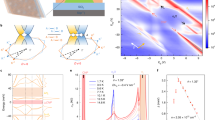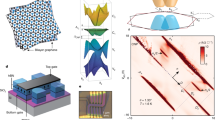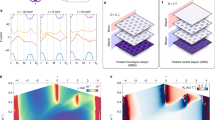Abstract
The recent discovery of correlated insulator states and superconductivity in magic-angle twisted bilayer graphene1,2 has enabled the experimental investigation of electronic correlations in tunable flat-band systems realized in twisted van der Waals heterostructures3,4,5,6. This novel twist angle degree of freedom and control should be generalizable to other two-dimensional systems, which may exhibit similar correlated physics behaviour, and could enable techniques to tune and control the strength of electron–electron interactions. Here we report a highly tunable correlated system based on small-angle twisted bilayer–bilayer graphene (TBBG), consisting of two rotated sheets of Bernal-stacked bilayer graphene. We find that TBBG exhibits a rich phase diagram, with tunable correlated insulator states that are highly sensitive to both the twist angle and the application of an electric displacement field, the latter reflecting the inherent polarizability of Bernal-stacked bilayer graphene7,8. The correlated insulator states can be switched on and off by the displacement field at all integer electron fillings of the moiré unit cell. The response of these correlated states to magnetic fields suggests evidence of spin-polarized ground states, in stark contrast to magic-angle twisted bilayer graphene. Furthermore, in the regime of lower twist angles, TBBG shows multiple sets of flat bands near charge neutrality, resulting in numerous correlated states corresponding to half-filling of each of these flat bands, all of which are tunable by the displacement field as well. Our results could enable the exploration of twist-angle- and electric-field-controlled correlated phases of matter in multi-flat-band twisted superlattices.
This is a preview of subscription content, access via your institution
Access options
Access Nature and 54 other Nature Portfolio journals
Get Nature+, our best-value online-access subscription
$29.99 / 30 days
cancel any time
Subscribe to this journal
Receive 51 print issues and online access
$199.00 per year
only $3.90 per issue
Buy this article
- Purchase on Springer Link
- Instant access to full article PDF
Prices may be subject to local taxes which are calculated during checkout




Similar content being viewed by others
Data availability
The data that support the findings of this study are available from the corresponding authors upon reasonable request.
Change history
02 July 2020
A Correction to this paper has been published: https://doi.org/10.1038/s41586-020-2393-7
References
Cao, Y. et al. Correlated insulator behaviour at half-filling in magic-angle graphene superlattices. Nature 556, 80–84 (2018).
Cao, Y. et al. Unconventional superconductivity in magic-angle graphene superlattices. Nature 556, 43–50 (2018).
Suárez Morell, E., Correa, J. D., Vargas, P., Pacheco, M. & Barticevic, Z. Flat bands in slightly twisted bilayer graphene: tight-binding calculations. Phys. Rev. B 82, 121407 (2010).
Bistritzer, R. & MacDonald, A. H. Moiré bands in twisted double-layer graphene. Proc. Natl Acad. Sci. USA 108, 12233–12237 (2011).
Lopes dos Santos, J. M. B., Peres, N. M. R. & Castro Neto, A. H. Continuum model of the twisted graphene bilayer. Phys. Rev. B 86, 155449 (2012).
Carr, S. et al. Twistronics: manipulating the electronic properties of two-dimensional layered structures through their twist angle. Phys. Rev. B 95, 075420 (2017).
McCann, E. & Koshino, M. The electronic properties of bilayer graphene. Rep. Prog. Phys. 76, 056503 (2013).
Castro Neto, A. H., Guinea, F., Peres, N. M. R., Novoselov, K. S. & Geim, A. K. The electronic properties of graphene. Rev. Mod. Phys. 81, 109–162 (2009).
Yankowitz, M. et al. Tuning superconductivity in twisted bilayer graphene. Science 363, 1059–1064 (2019).
Sharpe, A. L. et al. Emergent ferromagnetism near three-quarters filling in twisted bilayer graphene. Science 365, 605–608 (2019).
Lu, X. et al. Superconductors, orbital magnets and correlated states in magic-angle bilayer graphene. Nature 574, 653–657 (2019).
Hunt, B. et al. Massive Dirac fermions and Hofstadter butterfly in a van der Waals heterostructure. Science 340, 1427–1430 (2013).
Ponomarenko, L. A. et al. Cloning of Dirac fermions in graphene superlattices. Nature 497, 594–597 (2013).
Dean, C. R. et al. Hofstadter’s butterfly and the fractal quantum Hall effect in moiré superlattices. Nature 497, 598–602 (2013).
Krishna Kumar, R. et al. High-temperature quantum oscillations caused by recurring Bloch states in graphene superlattices. Science 357, 181–184 (2017).
Li, G. et al. Observation of Van Hove singularities in twisted graphene layers. Nat. Phys. 6, 109–113 (2010).
Chen, G. et al. Evidence of a gate-tunable Mott insulator in a trilayer graphene moiré superlattice. Nat. Phys. 15, 237–241 (2019).
Chen, G. et al. Signatures of tunable superconductivity in a trilayer graphene moiré superlattice. Nature 572, 215–219 (2019).
Oostinga, J. B., Heersche, H. B., Liu, X., Morpurgo, A. F. & Vandersypen, L. M. K. Gate-induced insulating state in bilayer graphene devices. Nat. Mater. 7, 151–157 (2008).
Zhang, Y. et al. Direct observation of a widely tunable bandgap in bilayer graphene. Nature 459, 820–823 (2009).
Zhang, Y.-H., Mao, D., Cao, Y., Jarillo-Herrero, P. & Senthil, T. Nearly flat Chern bands in moiré superlattices. Phys. Rev. B 99, 075127 (2019).
Cao, Y. et al. Superlattice-induced insulating states and valley-protected orbits in twisted bilayer graphene. Phys. Rev. Lett. 117, 116804 (2016).
Kim, Y. et al. Charge inversion and topological phase transition at a twist angle induced Van Hove singularity of bilayer graphene. Nano Lett. 16, 5053–5059 (2016).
Koshino, M. Band structure and topological property of twisted double bilayer graphenes. Phys. Rev. B 99, 235406 (2019).
Polshyn, H. et al. Large linear-in-temperature resistivity in twisted bilayer graphene. Nat. Phys. 15, 1011–1016 (2019).
Cao, Y. et al. Strange metal in magic-angle graphene with near Planckian dissipation. Phys. Rev. Lett. 124, 076801 (2020).
Lee, J. Y. et al. Theory of correlated insulating behaviour and spin-triplet superconductivity in twisted double bilayer graphene. Nat. Commun. 10, 5333 (2019).
Raymond, A. et al. Gigantic exchange enhancement of spin g-factor for two-dimensional electron gas in GaAs. Solid State Commun. 55, 271–274 (1985).
Young, A. F. et al. Spin and valley quantum Hall ferromagnetism in graphene. Nat. Phys. 8, 550–556 (2012).
Pizzocchero, F. et al. The hot pick-up technique for batch assembly of van der Waals heterostructures. Nat. Commun. 7, 11894 (2016).
Purdie, D. G. et al. Cleaning interfaces in layered materials heterostructures. Nat. Commun. 9, 5387 (2018).
Wang, L. et al. One-dimensional electrical contact to a two-dimensional material. Science 342, 614–617 (2013).
Acknowledgements
We acknowledge discussions with S. Todadri, L. Fu, P. Kim, X. Liu, S. Fang and E. Kaxiras. This work was supported by the National Science Foundation under award DMR-1809802 (data analysis by Y.C.), the Center for Integrated Quantum Materials under NSF grant DMR-1231319 (fabrication by D.R.-L.), the US DOE, BES Office, Division of Materials Sciences and Engineering under award DE-SC0001819 (g-factor analysis by J.M.P.), and the Gordon and Betty Moore Foundation's EPiQS Initiative through grant GBMF4541 to P.J.-H. K.W. and T.T. acknowledge support from the Elemental Strategy Initiative conducted by the MEXT, Japan, A3 Foresight by JSPS and the CREST (JPMJCR15F3), JST. This work made use of the Materials Research Science and Engineering Center Shared Experimental Facilities supported by the National Science Foundation (DMR-0819762) and of Harvard’s Center for Nanoscale Systems, supported by the NSF (ECS-0335765). D.R.-L. acknowledges partial support from Fundació Bancaria “la Caixa” (LCF/BQ/AN15/10380011) and from the US Army Research Office grant number W911NF-17-S-0001 (measurements). O.R.-B. acknowledges support from Fundació Privada Cellex.
Author information
Authors and Affiliations
Contributions
Y.C., D.R.-L., O.R.-B. and J.M.P contributed to sample fabrication and transport measurements. Y.C., D.R.-L., O.R.-B., J.M.P and P.J.-H. performed data analysis. K.W. and T.T. provided h-BN samples. Y.C., D.R.-L., O.R.-B., J.M.P. and P.J.-H. wrote the manuscript with input from all co-authors.
Corresponding authors
Ethics declarations
Competing interests
The authors declare no competing interests.
Additional information
Peer review information Nature thanks Ming-Hao Liu, Hu-Jong Lee and the other, anonymous, reviewer(s) for their contribution to the peer review of this work.
Publisher’s note Springer Nature remains neutral with regard to jurisdictional claims in published maps and institutional affiliations.
Extended data figures and tables
Extended Data Fig. 1 Vtg–Vbg resistance maps of measured TBBG devices.
a–f, Resistance versus Vtg and Vbg for the six TBBG devices measured, which correspond to the six rows shown in Extended Data Table 1, respectively. g, h, Cross-like feature near −ns/2 in TBBG samples with twist angles θ = 1.23° (g) and θ = 1.09° (h), which might signal the onset of a correlated state.
Extended Data Fig. 2 Landau fan diagrams and Hall mobilities of the TBBG devices.
a, Resistance of the 1.09° sample versus carrier density and perpendicular magnetic field. b, Hall mobility μHall (left axis) and Hall coefficient RH (right axis) in the 1.09° sample at different carrier densities. c–f, Same measurements as in a, b but for the 0.84° (c, d) and 1.23° (e, f) samples, respectively. All measurements are taken at T < 100 mK. The data for the 1.09° device are taken at D/ε0 = 0.2 V nm−1 while the data for the other two devices are taken at D = 0.
Extended Data Fig. 3 Linear resistance versus temperature behaviour in TBBG.
a, b, Resistance versus temperature curves at different charge densities in the 1.23° sample for the electron-doping side (a) and the hole-doping side (b). The inset in a shows the slope dRxx/dT of the linear R–T behaviour as a function of n for T >10 K. c, Selected R–T curves near ns/2 from a. d, Similar linear R–T behaviour in the 1.09° device. The inset shows the slope dRxx/dT. e, Density-dependent sublinear/linear R–T behaviour in the 0.84° device. The inset shows the slope dRxx/dT versus n in log–log scale. The slope is proportional to n to the power of −1.77.
Extended Data Fig. 4 Additional magnetic field response of TBBG devices.
a–d, Response of the ns/4 (a, b) and 3ns/4 (c, d) states in perpendicular magnetic field (a, c) and in-plane magnetic field (b, d) for the θ =1.23° device.
Extended Data Fig. 5 I–V curves in the 1.23° TBBG device at different carrier densities.
D/ε0 = −0.38 V nm−1. a–c, The densities correspond approximately to the ns/4 (a) and ns/2 (c) insulating states while the density for b lies between them. The left axis is the longitudinal voltage Vxx and the right axis is the differential resistance dVxx/dIb.
Extended Data Fig. 6 Comparison of the gap sizes and the g-factor using small and large excitations.
a, b, The Arrhenius fits of the resistance at the ns/2 state of the 1.23° TBBG device in an in-plane magnetic field. c, d, The same fits for the ns/4 state. a and c are measured using a current excitation of 0.1 nA, while b and d are measured using a voltage excitation of around 100 μV, which induces a current of around 5–10 nA in the sample. The insets in each panel show the corresponding g-factor fittings. In general, by using an excessive excitation, both the energy gaps and the g-factor will be underestimated.
Rights and permissions
About this article
Cite this article
Cao, Y., Rodan-Legrain, D., Rubies-Bigorda, O. et al. Tunable correlated states and spin-polarized phases in twisted bilayer–bilayer graphene. Nature 583, 215–220 (2020). https://doi.org/10.1038/s41586-020-2260-6
Received:
Accepted:
Published:
Issue Date:
DOI: https://doi.org/10.1038/s41586-020-2260-6
This article is cited by
-
Correlated insulator and Chern insulators in pentalayer rhombohedral-stacked graphene
Nature Nanotechnology (2024)
-
Electric field tunable bandgap in twisted double trilayer graphene
npj 2D Materials and Applications (2024)
-
A 2D ferroelectric vortex pattern in twisted BaTiO3 freestanding layers
Nature (2024)
-
Twisted photonic Weyl meta-crystals and aperiodic Fermi arc scattering
Nature Communications (2024)
-
Green-light p-n junction particle inhomogeneous phase enhancement of MgB2 smart meta-superconductors
Journal of Materials Science: Materials in Electronics (2024)
Comments
By submitting a comment you agree to abide by our Terms and Community Guidelines. If you find something abusive or that does not comply with our terms or guidelines please flag it as inappropriate.



